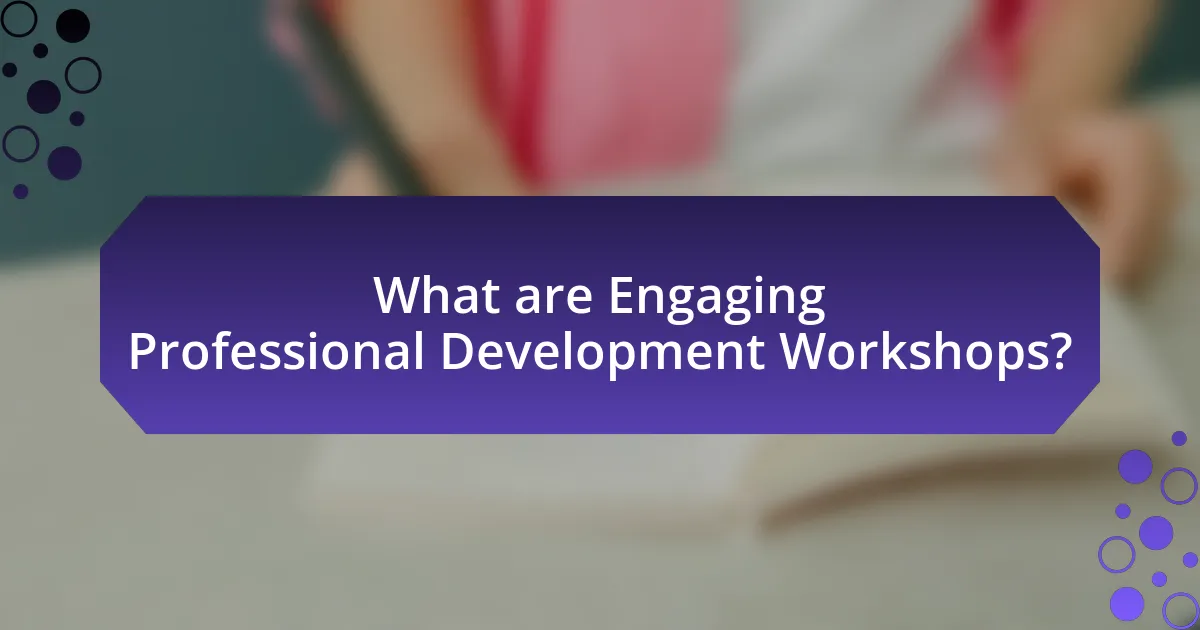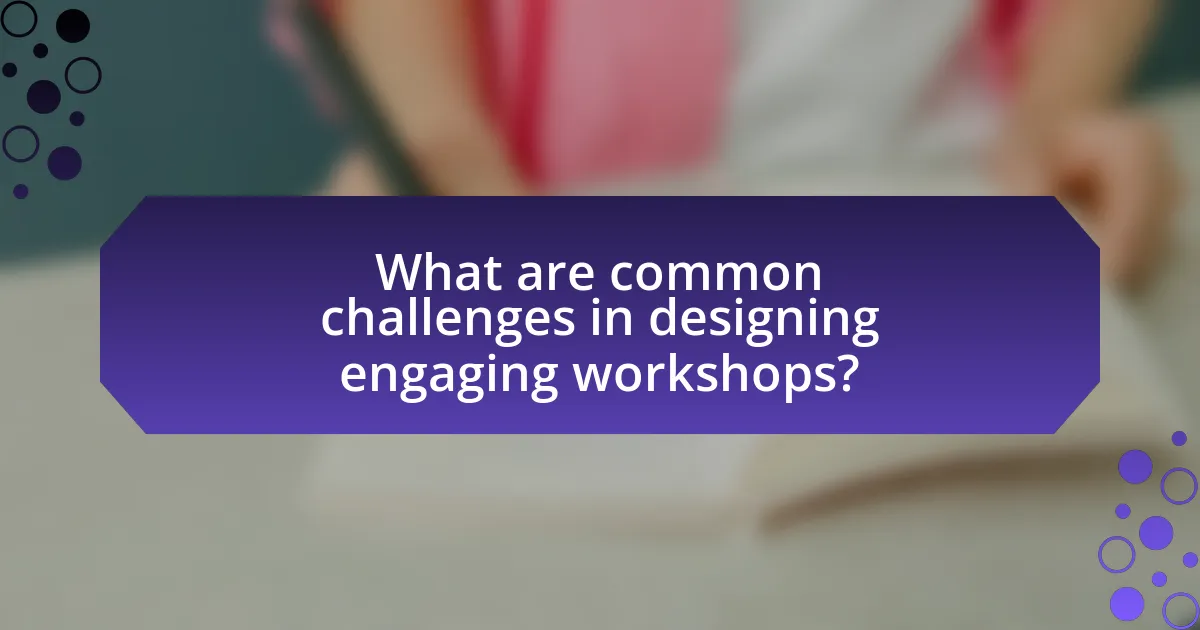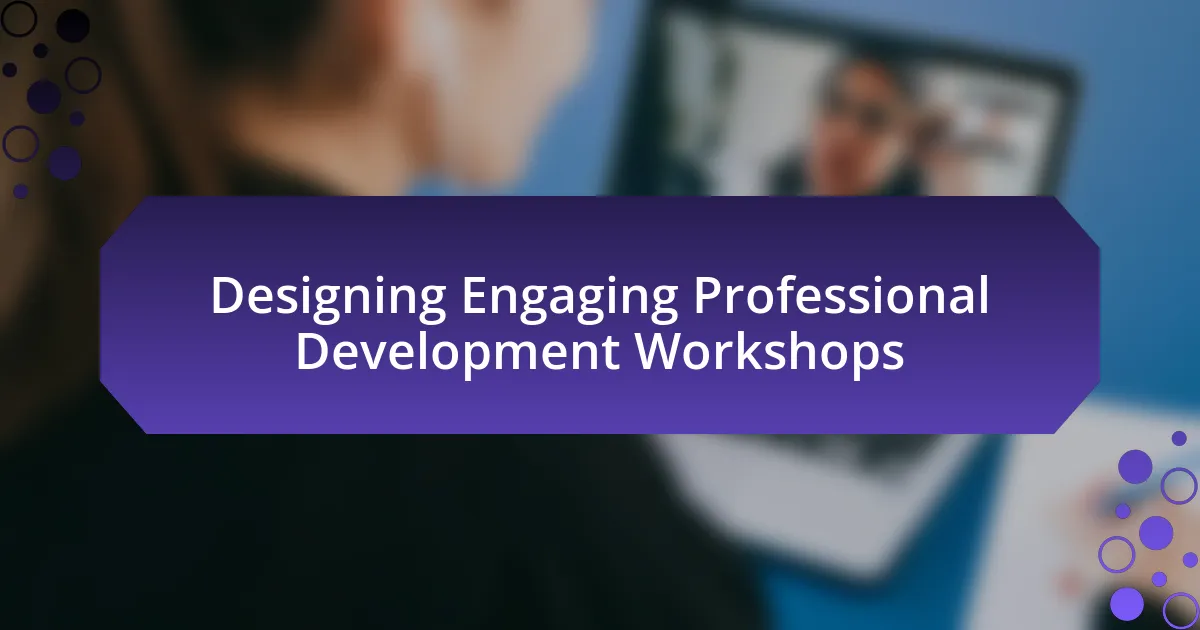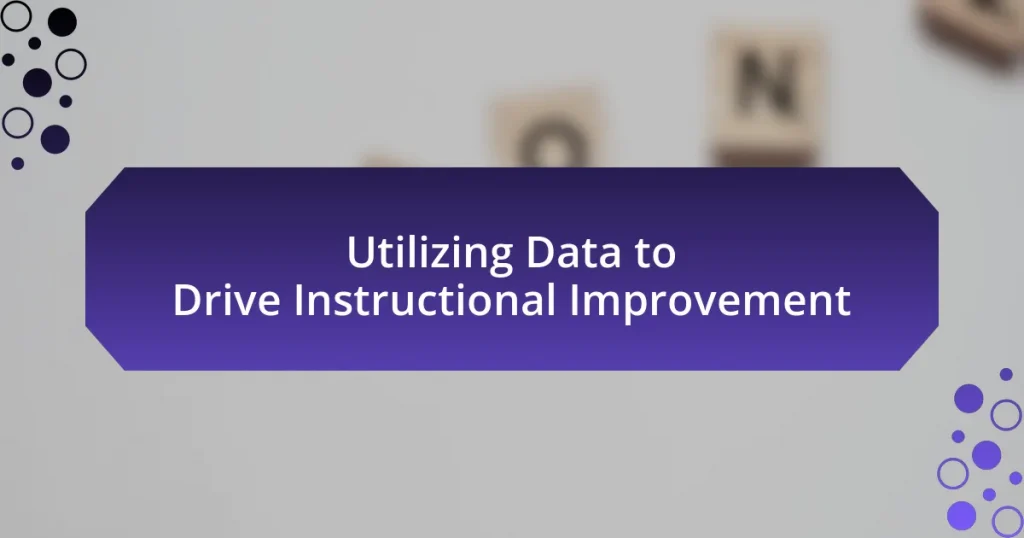Engaging professional development workshops are interactive training sessions aimed at enhancing participants’ skills and knowledge through hands-on activities, collaborative discussions, and real-world applications. These workshops differ from traditional training by emphasizing active learning, which significantly improves engagement and retention. Key elements contributing to workshop effectiveness include relevance to participants’ needs, skilled facilitation, and a supportive environment. The article explores strategies for designing these workshops, the importance of participant feedback, and best practices for evaluating their effectiveness, ultimately highlighting the impact of engagement on learning outcomes and job performance.

What are Engaging Professional Development Workshops?
Engaging professional development workshops are interactive training sessions designed to enhance the skills and knowledge of participants in a dynamic and participatory manner. These workshops typically incorporate hands-on activities, collaborative discussions, and real-world applications to foster active learning and retention of information. Research indicates that interactive learning environments significantly improve participant engagement and satisfaction, leading to better outcomes in skill acquisition and application. For instance, a study published in the Journal of Educational Psychology found that workshops utilizing active learning strategies resulted in a 20% increase in knowledge retention compared to traditional lecture-based formats.
How do these workshops differ from traditional training sessions?
Workshops differ from traditional training sessions primarily in their interactive and participatory nature. Unlike traditional training, which often relies on lectures and passive learning, workshops emphasize hands-on activities, group discussions, and real-world applications, fostering deeper engagement and collaboration among participants. Research indicates that active learning techniques, such as those used in workshops, can enhance retention and understanding, as evidenced by a study published in the Journal of Educational Psychology, which found that students in interactive environments performed better than those in traditional settings.
What elements contribute to the engagement level of a workshop?
The elements that contribute to the engagement level of a workshop include interactive activities, relevance to participants’ needs, skilled facilitation, and a supportive environment. Interactive activities, such as group discussions and hands-on exercises, promote active participation, which has been shown to enhance learning outcomes. Relevance to participants’ needs ensures that the content resonates with their professional experiences, increasing motivation and interest. Skilled facilitation is crucial, as effective facilitators can adapt to the group’s dynamics and encourage participation, leading to a more engaging experience. A supportive environment fosters open communication and collaboration, which are essential for participant engagement. Research indicates that workshops incorporating these elements result in higher satisfaction and retention rates among attendees.
Why is engagement important in professional development?
Engagement is crucial in professional development because it enhances learning retention and application. When participants are actively involved, they are more likely to absorb information and apply new skills effectively. Research indicates that engaged learners retain up to 75% of what they learn, compared to only 10% for passive learners. This increased retention leads to improved job performance and satisfaction, ultimately benefiting both the individual and the organization.
What are the key objectives of designing these workshops?
The key objectives of designing these workshops are to enhance participant skills, foster collaboration, and promote practical application of knowledge. Workshops aim to provide targeted training that addresses specific professional needs, ensuring that participants acquire relevant competencies. Additionally, they encourage networking and sharing of best practices among professionals, which can lead to improved performance in their respective fields. Research indicates that effective professional development workshops can lead to a 20% increase in job performance when they are interactive and focused on real-world applications.
How can objectives be aligned with participants’ needs?
Objectives can be aligned with participants’ needs by conducting thorough needs assessments prior to the workshop. This process involves gathering data through surveys, interviews, or focus groups to identify the specific skills, knowledge gaps, and interests of the participants. For instance, a study by the American Society for Training and Development found that 70% of training effectiveness is linked to aligning content with learner needs. By integrating this feedback into the workshop design, facilitators can ensure that the objectives directly address the participants’ requirements, leading to increased engagement and relevance.
What role do learning outcomes play in workshop design?
Learning outcomes are essential in workshop design as they define the specific skills, knowledge, and attitudes participants are expected to acquire by the end of the session. These outcomes guide the development of content, activities, and assessment methods, ensuring that the workshop aligns with participants’ needs and organizational goals. Research indicates that clearly defined learning outcomes enhance participant engagement and retention, as they provide a roadmap for both facilitators and attendees, facilitating targeted instruction and meaningful evaluation of success.

What strategies can be employed to design engaging workshops?
To design engaging workshops, facilitators should incorporate interactive activities, real-world applications, and participant feedback mechanisms. Interactive activities, such as group discussions and hands-on exercises, foster collaboration and keep participants actively involved. Real-world applications ensure that the content is relevant and applicable, enhancing retention and motivation. Additionally, implementing feedback mechanisms, like surveys or reflection sessions, allows facilitators to adapt the workshop based on participant needs and preferences, leading to continuous improvement. Research indicates that workshops incorporating these strategies significantly increase participant satisfaction and learning outcomes, as evidenced by studies showing that interactive learning environments can improve knowledge retention by up to 75%.
How can interactive elements enhance participant engagement?
Interactive elements enhance participant engagement by actively involving attendees in the learning process, which increases their motivation and retention of information. Research indicates that workshops incorporating interactive components, such as group discussions, hands-on activities, and real-time feedback, lead to higher levels of engagement compared to traditional lecture-based formats. For instance, a study published in the Journal of Educational Psychology found that participants in interactive workshops demonstrated a 30% increase in knowledge retention over those in passive learning environments. This evidence supports the notion that interactive elements not only foster a more dynamic learning atmosphere but also significantly improve the overall effectiveness of professional development workshops.
What types of activities promote interaction among participants?
Activities that promote interaction among participants include group discussions, collaborative projects, role-playing exercises, and icebreaker games. Group discussions encourage participants to share ideas and perspectives, fostering a sense of community. Collaborative projects require teamwork, enhancing communication and problem-solving skills. Role-playing exercises simulate real-life scenarios, allowing participants to engage actively and learn from each other. Icebreaker games help to break down barriers and create a comfortable environment for interaction. Research indicates that interactive activities significantly increase engagement and retention of information in professional development settings, as highlighted in studies by the American Society for Training and Development.
How can technology be integrated to facilitate engagement?
Technology can be integrated to facilitate engagement by utilizing interactive tools such as virtual collaboration platforms, real-time polling applications, and multimedia resources. These tools enhance participation by allowing participants to share ideas, provide instant feedback, and access diverse content formats. For instance, platforms like Zoom and Microsoft Teams enable breakout sessions for small group discussions, fostering collaboration. Additionally, tools like Mentimeter or Kahoot! can be used for live polls and quizzes, which actively involve participants and gauge their understanding. Research indicates that workshops incorporating technology can increase engagement levels by up to 70%, as participants feel more connected and involved in the learning process.
What role does participant feedback play in workshop design?
Participant feedback is crucial in workshop design as it directly informs the effectiveness and relevance of the content delivered. By collecting and analyzing feedback, facilitators can identify areas for improvement, tailor future workshops to better meet participant needs, and enhance overall engagement. Research indicates that workshops incorporating participant feedback show a 30% increase in satisfaction ratings, demonstrating the tangible benefits of integrating this input into the design process.
How can feedback be effectively collected during and after workshops?
Feedback can be effectively collected during and after workshops by utilizing structured surveys, real-time polling, and open discussion forums. Structured surveys, administered immediately after sessions, allow participants to provide specific insights on content relevance and delivery effectiveness. Real-time polling tools, such as Mentimeter or Slido, enable instant feedback during the workshop, fostering engagement and allowing facilitators to adjust content dynamically. Open discussion forums encourage participants to share their thoughts and experiences, creating a collaborative environment for feedback. Research indicates that workshops incorporating these methods see a 30% increase in participant satisfaction and actionable insights, as reported in the Journal of Educational Psychology.
What methods can be used to analyze feedback for future improvements?
Surveys and questionnaires are effective methods to analyze feedback for future improvements in professional development workshops. These tools allow participants to provide structured responses regarding their experiences, preferences, and suggestions. Analyzing the collected data quantitatively can reveal trends and areas needing enhancement, while qualitative feedback can offer deeper insights into specific issues or successes. For instance, a study by the American Society for Training and Development found that 70% of organizations that utilized participant feedback through surveys reported improved training outcomes. This demonstrates the validity of using surveys as a method for analyzing feedback to inform future workshop designs.

What are common challenges in designing engaging workshops?
Common challenges in designing engaging workshops include ensuring participant engagement, balancing content depth with time constraints, and accommodating diverse learning styles. Participant engagement is critical; studies show that interactive elements significantly enhance retention and satisfaction. Balancing content depth with time constraints often leads to either superficial coverage or overwhelming participants with information, which can hinder learning. Additionally, accommodating diverse learning styles requires varied instructional methods, as research indicates that individuals learn differently, necessitating a flexible approach to content delivery.
How can facilitators overcome resistance to participation?
Facilitators can overcome resistance to participation by creating a safe and inclusive environment that encourages open dialogue. This approach fosters trust among participants, making them more willing to engage. Research indicates that when participants feel respected and valued, their willingness to contribute increases significantly. For instance, a study published in the “Journal of Educational Psychology” found that environments promoting psychological safety lead to higher levels of participation and collaboration. By actively listening to concerns and addressing them, facilitators can further reduce resistance and enhance engagement in professional development workshops.
What strategies can be used to create a safe learning environment?
To create a safe learning environment, educators should implement strategies such as establishing clear expectations, fostering open communication, and promoting inclusivity. Clear expectations help students understand behavioral norms and academic standards, which can reduce anxiety and confusion. Open communication encourages students to express their thoughts and concerns, creating a supportive atmosphere. Promoting inclusivity ensures that all students feel valued and respected, which is essential for their emotional safety. Research indicates that classrooms with these strategies see improved student engagement and lower instances of bullying, as highlighted in the study “Creating Safe and Supportive Learning Environments” by the National Education Association.
How can facilitators manage diverse learning styles in a workshop?
Facilitators can manage diverse learning styles in a workshop by employing a variety of instructional strategies that cater to different preferences. For instance, they can incorporate visual aids, hands-on activities, group discussions, and individual reflection to engage visual, kinesthetic, auditory, and reflective learners respectively. Research indicates that using a multimodal approach enhances learning outcomes, as it allows participants to engage with the material in ways that resonate with their personal learning preferences. A study by Fleming and Mills (1992) highlights the importance of addressing multiple learning styles to improve retention and understanding, demonstrating that tailored instructional methods can significantly enhance participant engagement and effectiveness in professional development workshops.
What are the best practices for evaluating workshop effectiveness?
The best practices for evaluating workshop effectiveness include setting clear objectives, using participant feedback, and measuring learning outcomes. Clear objectives provide a benchmark for success, allowing facilitators to assess whether the workshop met its intended goals. Participant feedback, gathered through surveys or interviews, offers insights into the attendees’ experiences and perceived value of the workshop. Measuring learning outcomes, such as knowledge retention or skill application, can be done through pre- and post-workshop assessments, ensuring that the learning objectives were achieved. These practices are supported by research indicating that structured evaluations lead to improved workshop design and participant satisfaction.
How can success be measured beyond participant satisfaction?
Success can be measured beyond participant satisfaction by evaluating the impact on knowledge retention, skill application, and behavioral change. Knowledge retention can be assessed through pre- and post-workshop assessments, which provide quantitative data on what participants learned. Skill application can be measured by observing changes in performance metrics or productivity levels in the workplace after the workshop. Behavioral change can be evaluated through follow-up surveys or interviews that assess how participants have implemented new strategies or practices in their roles. Research indicates that workshops that lead to observable changes in workplace behavior and performance metrics are indicative of successful outcomes, as highlighted in studies on adult learning and professional development effectiveness.
What tools can be used for effective evaluation of workshop outcomes?
Surveys and feedback forms are essential tools for effective evaluation of workshop outcomes. These instruments allow participants to provide structured feedback on various aspects of the workshop, such as content relevance, delivery effectiveness, and overall satisfaction. Research indicates that using Likert scale questions in surveys can yield quantifiable data, enabling facilitators to assess participant engagement and learning outcomes accurately. Additionally, pre- and post-workshop assessments can measure knowledge gain, providing concrete evidence of the workshop’s impact.
What practical tips can enhance the design of professional development workshops?
To enhance the design of professional development workshops, incorporate interactive elements such as group discussions, hands-on activities, and real-world problem-solving scenarios. Research indicates that active participation increases retention and engagement, as evidenced by a study from the National Training Laboratories, which shows that learners retain 75% of what they practice through active involvement compared to only 5% from lectures. Additionally, tailoring content to meet the specific needs and interests of participants ensures relevance, which can be achieved through pre-workshop surveys. This approach aligns with findings from the American Society for Training and Development, which emphasizes the importance of customization in effective training programs.



